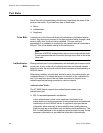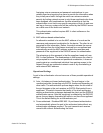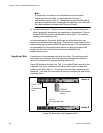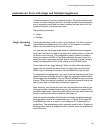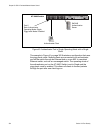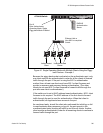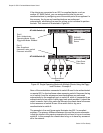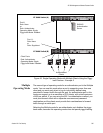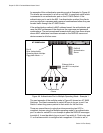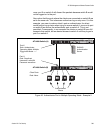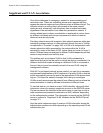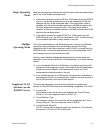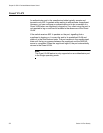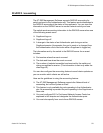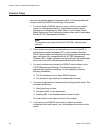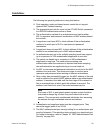
Chapter 31: 802.1x Port-based Network Access Control
368 Section VIII: Port Security
An example of this authenticator operating mode is illustrated in Figure 44.
The clients are connected to a hub or non-802.1x-compliant switch which
is connected to an authenticator port on the AT-9400 Switch. If the
authenticator port is set to the 802.1x authentication method, the clients
must provide their username and password combinations before they can
forward traffic through the AT-9400 Switch.
If the authentication method is MAC address-based, the authenticator port
uses the MAC addresses of the clients as the username and password
combinations. The port accepts and forwards traffic only from those clients
whose MAC addresses have been entered on the RADIUS server and
denies access to all other users.
Figure 44. Authenticator Port in Multiple Operating Mode - Example 1
The next example of the multiple mode in Figure 45 shows two AT-9400
Switches. The clients connected to switch B have to log on to port 6 on
Switch A when they pass a packet to that switch for the first time.
There are several items to note when interconnecting two 802.1x-
compliant devices using the Multiple operating mode of an authenticator
port. In order for switch B in our example to pass the RADIUS messages
to switch A, it must be able to log on to port 6 on switch A. That is why port
11 on the lower switch is configured as a supplicant. If its role is set to
AT-9400 Switch
FAULT
RPS
MASTER
POWER
CLASS 1
LASER PRODUCT
STATUS
TERMINAL
PORT
1357911
24681012
13 15 17 19 21 23R
14 16 18 20 22 24R
AT-9424T/SP
Gigabit Ethernet Switch
1357911131517192123R
2 4 6 8 10121416 18202224R
23 24
L/A
D/C
D/C
L/A
D/C
L/A
1000 LINK / ACT
HDX /
COL
FDX
10/100 LINK / ACT
PORT ACTIVITY
L/A
1000 LINK / ACT
SFP
SFP
24
SFP
23
RADIUS
Authentication
Server
Port 6
Role: Authenticator
Operating Mode: Multiple
Piggy-back Mode: -----
Ethernet Hub or
Non-802.1x-compliant
Switch
Authenticated
Clients



